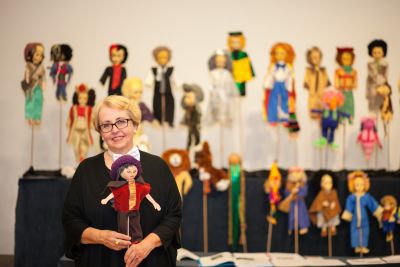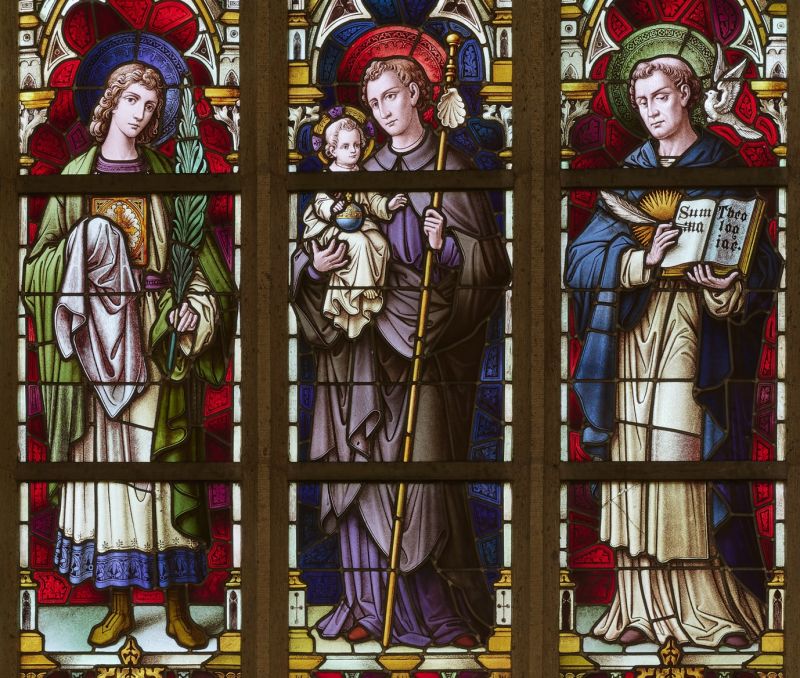Stanislaus Kostka in Recklinghausen-Suderwich. The portrayal of a Polish national saint in a stained-glass window in the St.-Johannes-Kirche church
Mediathek Sorted







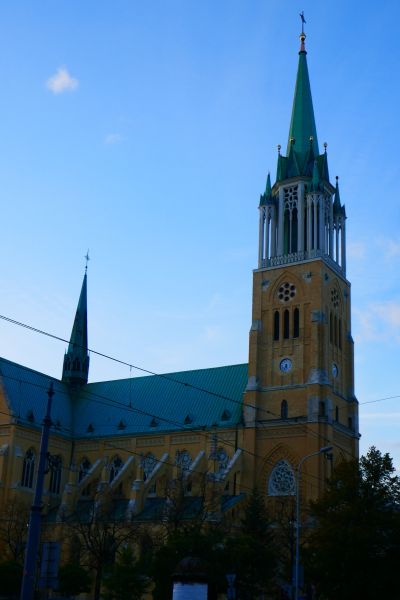


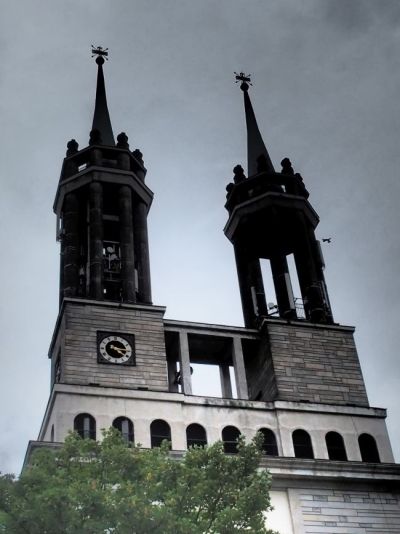
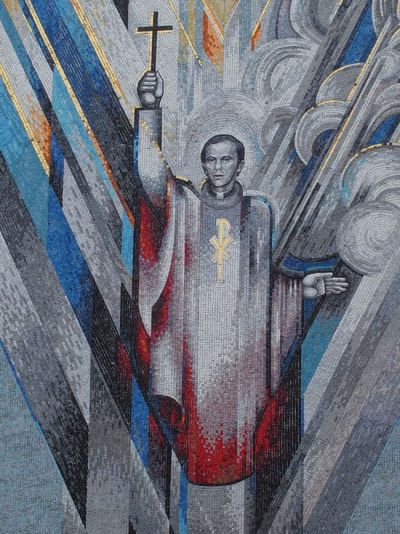







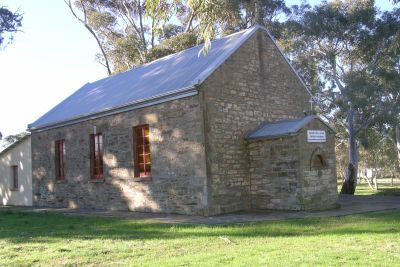









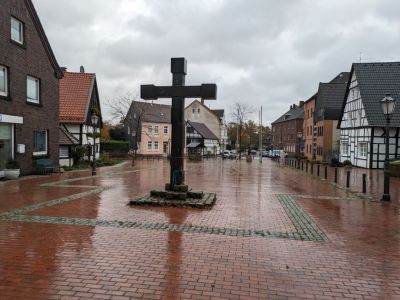


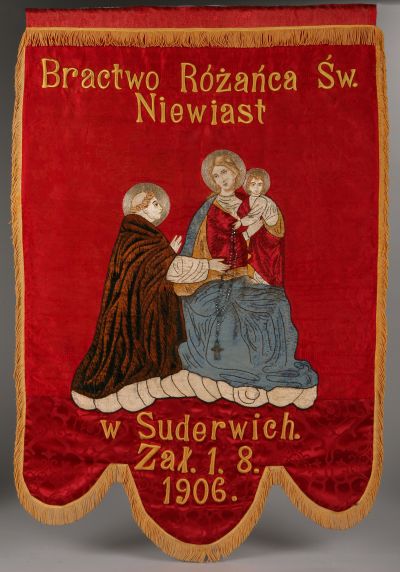














Stained-glass window cycle
The three stained-glass windows for the central apse behind the middle aisle of the neo-Gothic church in Suderwich were completed in 1904 by the stained-glass workshop run by Wilhelm Derix from Kevelaer. A further six windows for the adjacent choirs behind the two side aisles were installed in 1907. Each window is ten metres high and 2.20 metres wide. The windows are particularly well illuminated when the sun shines through during the morning. The workshop billed the congregation for 4,700 gold marks for the three windows in the main choir alone. According to the Suderwich author (and evangelical priest) Walter Zillessen, the bill was partially covered by the general vicariate of the bishopric of Münster. However, the costs were mainly borne by the church congregation. “As a result of the new mines and the sale of church lands to the mining companies, the congregation was not without financial means. In addition, there were the church societies at that time who were happy to contribute, as were wealthy individuals in the congregation.” (Zillessen, 1987)
Zillessen also assumes that the images portrayed in the windows were designed by the local priest, Heinrich Hauling. Hauling was considered an “art lover”; before his time in office in Suderwich (1884–1921), he was chaplain at Darfeld Palace in the Münsterland region, where he came into contact with the “Westphalian spiritual leadership at that time”. The aged priest (who was born in 1831) was enthusiastically supported in the church building project by his chaplain, Hermann Öchtering, who was otherwise responsible for the pastoral care of the immigrants, and who – unsuccessfully – campaigned in 1906 for the Polish miners to be accepted into the “German” miners’ associations. Given this context, it is likely that it was Öchtering who suggested that Stanislaus Kostka should be portrayed in the Suderwich window cycle.
The nine choir windows are a colourful testament to the religious affiliation of a Catholic Ruhr region community at the beginning of the 20th century. The presence of Stanislaus Kostka in this harmonious series of images is not the only reminder of the Ruhr Poles who once lived here. The highly symbolic representation of the transfiguration of St. Joseph was also included to reflect the pastoral care of the Poles, since in Suderwich, Jesus’ foster father was revered as a patron saint by not just one Polish society, but two.
Each of the nine choir windows shows a scene from the life of Jesus, the mother of God or St. Joseph in the upper section. The lower section of most of the windows contains images of saints. In the apse of the middle aisle, the crucifixion of Christ is the central element, flanked by depictions of the baptism of Jesus by John the Baptist and John the Baptist’s decapitation [ , , ]. The choir chapel behind the left-hand side aisle is dedicated to the mother of God. The central window celebrates her ascension to Heaven. To the left, Maria is shown as a young girl visiting the temple; to the right as Pietà, with her dead son in her lap. The central window also shows Adam and Eve being driven from Paradise [ , , , ].
The three stained-glass windows at the end of the right-hand side aisle are dedicated to St. Joseph. The right-hand window shows his carpentry workshop. To the left, we see Joseph explaining the holy scripture to his family – the mother of God and the boy Jesus [ , ].
The central window shows him as the patron saint of the church, surrounded by four angels presenting the insignia of the papal primate: two crossed keys, a shepherd’s crook with three crosses, St. Peter’s Basilica in Rome, and the tiara. The lower section of the window shows a peasant on the left-hand side and a miner on the right, both of whom look up to Joseph with folded hands. To the left, the bell tower of the village church in Suderwich has been added to the picture; to the right, a pit frame from the King Ludwig IV/V mine [ , ].
In this way, not only is Joseph venerated, but the papal claim of primacy in Recklinghausen-Suderwich is also shown. This claim is further underlined in the centre of the lower area of the window. Here, Pius IX (1792–1878) is shown on his throne, who in 1870 had a definition of papal “infallibility” set down in writing by the First Vatican Council. In his left hand, he holds a document bearing the inscription “Decretum 7 July 1871”. In this text, the Pope reports that the general sense of anxiety following the outbreak (in 1870) of the Franco-German War had led to a huge increase in the veneration of Joseph among believers. As a result, the Council fathers had implored him – “in these sombre times, to drive away all evil” – to more effectively ask for God’s mercy through the intercession of St. Joseph by declaring him Patronus Ecclesiae. He said that he had agreed to their request, and that on 8 December 1870, he had ceremonially declared the foster father of Jesus the patron saint of the entire Catholic Church.
In several cases, the saints represented in the lower section of the Suderwich choir window have been selected with the Ruhr region in mind. For example, Barbara, the patron saint of mining, is shown, as is Elizabeth, patron saint of charitable service [ ]. Stanislaus Kostka is portrayed in the right-hand side window of the main choir. He is flanked on the right by the famous religious teacher Thomas Aquinas, and to the left by the young martyr Tarcisius, who, according to popular legend, smuggled the sacred host to his incarcerated fellow believers at the time when Christians were being persecuted by the Romans [ ].
In the images shown in the windows, Stanislaus is shown holding a pilgrim’s rod with a St. James’s scallop in his left hand, indicating his pilgrimage on foot from Vienna to Rome. In his right arm, he holds the boy Jesus, whose universal rule is expressed by a small globe. This calls to mind the appearance of Mary before the feverish young Polish pupil in Vienna: in his mystical vision, the mother of God handed her son to him to hold.

